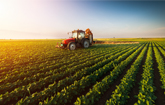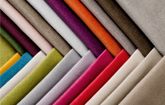DUBLIN, Oct. 7, 2022 /PRNewswire/ -- The "Global Agricultural Textiles Market by Fiber Material (Nylon, Polyester, PE, PP, Natural Fiber), Fabric Formation Technology (Woven, Knitted, Nonwoven), Product Type (Shade Nets, Mulch Mats), Application, and Region - Forecast to 2026" report has been added to ResearchAndMarkets.com's offering.
The Global Agricultural Textiles Market is projected to grow from USD 14.6 billion in 2021 to USD 19 billion by 2026, at a CAGR of 5.4% between 2021 and 2026. The key factor driving the growth of the market is increase in the area for greenhouse-protected cultivation.
Outdoor agriculture application segment is estimated to be the largest segment of the Agricultural Textiles market
Agricultural activities in uncontrolled environment such as fields and orchards are highly influenced by the environmental conditions. Fruits plantation such as apples require continuous attention to provide a good yield. In open environment crops can be easily destroyed by harsh sunlight or heavy rainfall, in colder regions colder temperatures and hail can lead to less yield.
Sunscreens, Anti-hail nets, anti-bird nets, ground covers, mulch nets are the commonly used textiles for outdoor agriculture. The textile used for outdoor purposes need high resistance to weather condition and resistance to abrasion. The use of agrotextile has been increasing and governments have been promoting the use by launching schemes.
Ground covers are highly effective in reducing the effects of UV rays on the soil hence preventing depletion of nutrients. The use of ground covers also help in regulating moisture and air flow in the soil.
Asia Pacific is the forecasted to be the fastest-growing Agricultural Textiles market during the forecast period
Asia Pacific is the largest agricultural textiles market globally. The growth is mainly attributed to the region's rising population. In addition, the demand is shifting to the Asia Pacific region due to economic contraction and saturation in the European and North American markets. Agricultural textiles manufacturers are targeting this region, as it is currently the strongest regional market. India is an agriculture-based economy. Increased cultivation is meeting the rising food demand of the population.
Due to the depleting arable land, the need for controlled agriculture has increased. Thus, the demand for agricultural textiles has grown. The demand for agricultural textiles is expected to increase in Singapore, Malaysia, Australia & New Zealand, and Indonesia because of the significant production and utilization of agricultural textiles expected in these countries between 2021 and 2026.
Key Topics Covered:
1 Introduction
2 Research Methodology
3 Executive Summary
4 Premium Insights
4.1 Significant Opportunities in Agricultural Textiles Market
4.2 Agricultural Textiles Market Size, by Fiber Material
4.3 Agricultural Textiles Market Growth, by Fabric Formation Technology
4.4 Agricultural Textiles Market Growth, by Product Type
4.5 Agricultural Textiles Market Growth, by Application
4.6 APAC: Agricultural Textiles Market, by Product Type and Country, 2020
4.7 Agricultural Textiles Market: Developed ss. Developing Countries
4.8 Agricultural Textiles Market, by Country
5 Market Overview
5.1 Introduction
5.2 Market Dynamics
5.2.1 Drivers
5.2.1.1 Global Focus on Increasing Agricultural Output
5.2.1.2 Importance of Controlled Agriculture in Greenhouses
5.2.1.3 Increased Demand for Greenhouse-Cultivated Crops
5.2.2 Restraints
5.2.2.1 Volatility in Raw Material Prices
5.2.3 Opportunities
5.2.3.1 Advancements in Technology
5.2.3.2 Opportunities in Horticulture
5.2.4 Challenges
5.2.4.1 Crop Protection and Weed Management
5.3 Porter's Five Forces Analysis
5.4 Macroeconomic Overview and Key Trends
5.4.1 Introduction
5.4.2 Trends and Forecast of GDP
5.4.3 Trends for Global Agricultural Industry
5.4.3.1 Decreasing Arable Land
5.4.3.2 Growing Production of High-Value Crops
5.4.3.3 Trends and Forecasts for Global Fisheries and Aquaculture Industry
5.5 COVID-19 Impact
5.5.1 COVID-19 Economic Assessment
5.5.2 COVID-19 Economic Impact - Scenario Assessment
5.6 Impact of COVID-19 on End-Use Industries
5.7 Shift in Agriculture Industry
5.7.1 Affected Areas
5.7.2 Future Scope and Reforms
5.8 Impact of COVID-19 on Regions
5.9 Value Chain Analysis
5.10 Pricing Analysis
5.11 Trends and Disruptions Impacting Customers
5.12 Trade Analysis
5.13 Regulations
5.14 Patent Analysis
5.15 Case Study Analysis
5.16 Technology Analysis
6 Agricultural Textile, by Fiber Material
6.1 Introduction
6.2 Nylon
6.2.1 Used for Fish Net and Shade Net Manufacturing
6.3 Polyester
6.3.1 Superior Heat and Water Resistance and High Strength Increasing Usage
6.4 Polyethylene
6.4.1 Polyethylene Accounts for Largest Market Share
6.5 Polypropylene
6.5.1 High Thermal Conductivity and Heat Retention for Longer Durations
6.6 Natural Fibers
6.6.1 Growing Concern for Climate Boosting Demand for Natural Fibers
6.7 Biodegradable Synthetic Fibers
6.7.1 Biodegradable Synthetic Fibers Gaining Popularity for Being Sustainable
6.8 Others
7 Agricultural Textile, by Fabric Formation Technology
7.1 Introduction
7.2 Woven
7.2.1 Oldest Method of Fabric Creation
7.3 Nonwoven
7.3.1 Improved Properties and Cost-Effectiveness
7.4 Knitted
7.4.1 Flexibility of Knitted Fabric Increasing Its Popularity
7.5 Others
8 Agricultural Textile, by Product Type
8.1 Introduction
8.2 Shade Nets/Cloths
8.2.1 Shade Nets/Cloths Accounts for Largest Market Share
8.3 Mulch Mats
8.3.1 Decrease Chores and Help Grow Bigger, Healthier, and More Productive Plants
8.4 Anti-Hail Nets and Bird Protection Nets
8.4.1 Protect from Insects and Pests and Help in Temperature & Ventilation Control
8.5 Fishing Nets
8.5.1 Emergence of Biodegradable Fishing Nets
8.6 Others
9 Agricultural Textile, by Application
9.1 Introduction
9.2 Outdoor Agriculture
9.2.1 Outdoor Agriculture Accounts for Largest Market Share
9.3 Controlled-Environment Agriculture
9.3.1 Insect Protection Nets Keep Pets Away from Greenhouse
10 Agricultural Textile, by Region
11 Competitive Landscape
11.1 Overview
11.1.1 Overview of Strategies Adopted by Key Agricultural Textiles Players
11.2 Company Evaluation Quadrant Matrix: Definitions and Methodology, 2020
11.2.1 Star
11.2.2 Emerging Leaders
11.2.3 Pervasive
11.2.4 Participants
11.3 Strength of Product Portfolio
11.4 Market Evaluation Matrix
11.5 Market Ranking Analysis
11.5.1 Beaulieu Technical Textiles
11.5.2 Belton Industries, Inc.
11.5.3 Hy-Tex (UK) Ltd.
11.5.4 Diatex SAS
11.5.5 Garware Technical Fibres Limited
11.5.6 Competitive Scenario and Trends
12 Company Profiles
12.1 Key Companies
12.1.1 Beaulieu Technical Textiles
12.1.2 Belton Industries, Inc.
12.1.3 Hy-Tex (UK) Ltd.
12.1.4 Diatex SAS
12.1.5 Garware Technical Fibres Limited
12.1.6 B&V Agro Irrigation Co.
12.1.7 Meyabond Industry & Trading (Beijing) Co. Ltd.
12.1.8 Neo Corp International Ltd.
12.1.9 Zhongshan Hongjun Nonwovens Co. Ltd.
12.1.10 Ludvig Svensson
12.2 Other Companies
12.2.1 Phormium
12.2.2 Drape Net Pty. Ltd.
12.2.3 Helios Group S.R.L.
12.2.4 Miller Net Company, Inc.
12.2.5 Siang May Pte. Ltd.
12.2.6 Memphis Net & Twine Co. Inc.
12.2.7 Nagaura Net Co. Inc.
12.2.8 Nitto Seimo Co. Ltd.
12.2.9 Badinotti Group S.p.A.
12.2.10 Hunan Xinhai Co. Ltd.
13 Appendix
For more information about this report visit https://www.researchandmarkets.com/r/pychhu
Media Contact:
Research and Markets
Laura Wood, Senior Manager
[email protected]
For E.S.T Office Hours Call +1-917-300-0470
For U.S./CAN Toll Free Call +1-800-526-8630
For GMT Office Hours Call +353-1-416-8900
U.S. Fax: 646-607-1907
Fax (outside U.S.): +353-1-481-1716
Logo: https://mma.prnewswire.com/media/539438/Research_and_Markets_Logo.jpg
SOURCE Research and Markets

WANT YOUR COMPANY'S NEWS FEATURED ON PRNEWSWIRE.COM?
Newsrooms &
Influencers
Digital Media
Outlets
Journalists
Opted In




Share this article